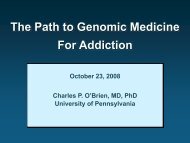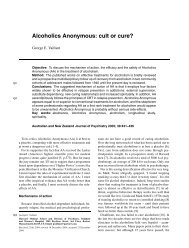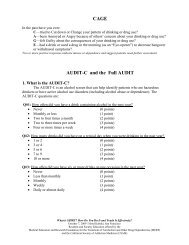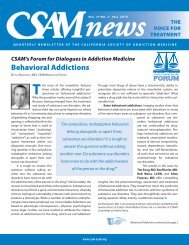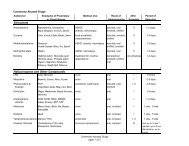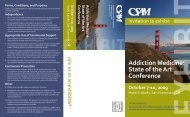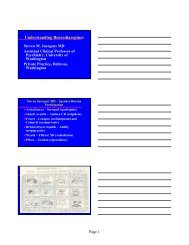SAN FRANCISCOMEDICINE - California Society of Addiction ...
SAN FRANCISCOMEDICINE - California Society of Addiction ...
SAN FRANCISCOMEDICINE - California Society of Addiction ...
You also want an ePaper? Increase the reach of your titles
YUMPU automatically turns print PDFs into web optimized ePapers that Google loves.
<strong>Addiction</strong> and Recovery<br />
San Francisco Roots<br />
The Evolution <strong>of</strong> <strong>Addiction</strong> Medicine<br />
David E. Smith, MD, FASAM, FAACT<br />
On May 2, 2009, the American<br />
Board <strong>of</strong> <strong>Addiction</strong> Medicine<br />
(ABAM) and Nora Volkow, MD,<br />
director <strong>of</strong> the National Institute <strong>of</strong> Drug<br />
Abuse, conferred board certification on<br />
nearly 1,500 physicians (myself included)<br />
representing a wide range <strong>of</strong> specialties.<br />
In her address at this ceremony,<br />
held during the annual meeting <strong>of</strong> the<br />
American <strong>Society</strong> <strong>of</strong> <strong>Addiction</strong> Medicine<br />
(ASAM), Dr. Volkow stated that “years<br />
<strong>of</strong> scientific research have proven drug<br />
addiction is a brain disease caused by<br />
biological, environmental, and development<br />
factors—a disease that can have<br />
far-reaching medical consequences. . . .<br />
Identifying drug use early, preventing its<br />
escalation to abuse and addiction, and<br />
referring patients in need <strong>of</strong> treatment<br />
are important medical skills” (Kunz and<br />
Gentilello 2009). With the passage <strong>of</strong><br />
health care reform and parity in March<br />
2010, addiction medicine has become a<br />
mainstream core benefit.<br />
Forty and more years ago, this would<br />
have been barely imaginable. <strong>Addiction</strong>s<br />
were stigmatized as moral failings and/<br />
or criminal activity. In reality, substance<br />
abuse in all its forms, including nicotine/<br />
cigarette addiction, alcoholism, and<br />
psychoactive dependence, represents<br />
our country’s number-one public health<br />
problem.<br />
Complementing this is the rise in<br />
prescription opioid abuse, particularly<br />
in adolescents, where prescription drug<br />
overdose deaths in 2008 exceeded all the<br />
overdose deaths for heroin, methamphetamine,<br />
and cocaine combined. Substance<br />
abuse is now the leading cause <strong>of</strong> death<br />
in young people, exceeding even traffic<br />
fatalities (Knudsen 2009).<br />
Alcoholism as a disease was clearly<br />
described as long ago as the late 1700s<br />
by Dr. Benjamin Rush, a physician and<br />
signer <strong>of</strong> the Declaration <strong>of</strong> Independence<br />
(Katcher 1993). However, it wasn’t until<br />
the formation <strong>of</strong> Alcoholics Anonymous<br />
(AA) in the 1930s by Bill Wilson and Dr.<br />
Bob Smith (no relation) that this concept<br />
<strong>of</strong> alcoholism as disease spread throughout<br />
the United States and subsequently<br />
the world. Dr. William Duncan Silkworth,<br />
in the Big Book <strong>of</strong> AA, described alcoholism<br />
as a disease caused by “an allergic reaction<br />
<strong>of</strong> the body to alcohol” and a compulsion<br />
<strong>of</strong> the mind (Silkworth, 1937).<br />
<strong>Addiction</strong> to other drugs, however,<br />
was specifically excluded from the scope<br />
<strong>of</strong> AA. AA emphasized that drug use other<br />
than alcohol was not to be disclosed at AA<br />
meetings. This prompted the formation<br />
<strong>of</strong> Narcotics Anonymous in <strong>California</strong><br />
in the 1950s, which was based on similar<br />
twelve-step principles but included<br />
recovery from all drugs <strong>of</strong> addiction,<br />
particularly opiates such as heroin, using<br />
the catchphrase “clean and sober.”<br />
Initiatives put forth by physicians<br />
in the New York <strong>Society</strong> <strong>of</strong> Alcoholism,<br />
a forerunner <strong>of</strong> ASAM, prompted the<br />
American Medical Association (AMA) to<br />
declare in the 1950s that alcoholism was<br />
a disease and to reaffirm this position in<br />
1966.<br />
In the late 1960s, the movement to<br />
recognize addiction as a disease escalated<br />
in <strong>California</strong>, particularly in San Francisco.<br />
Based on the principle that “health care<br />
is a right, not a privilege,” the Haight<br />
Ashbury Free Medical Clinic (HAFMC)<br />
was founded in response to the large<br />
number <strong>of</strong> drug-using youth who flocked<br />
to San Francisco’s Haight Ashbury district<br />
in 1967 for the “Summer <strong>of</strong> Love.” The<br />
Clinic’s experience with this population<br />
led to the philosophy that “addiction is<br />
a disease—the addict has a right to be<br />
treated” and prompted the almost immediate<br />
expansion <strong>of</strong> clinic services to drug<br />
crisis intervention and detoxification. The<br />
San Francisco Medical <strong>Society</strong> and the<br />
<strong>California</strong> Medical <strong>Society</strong> provided early<br />
support for these endeavors, despite the<br />
City’s refusal to address a major public<br />
health catastrophe (Heilig 2009).<br />
Dr. David Breithaupt <strong>of</strong> the University<br />
<strong>of</strong> <strong>California</strong>, San Francisco, Ambulatory<br />
and Community Medicine program,<br />
trained medical students at HAFMC. At<br />
a recent CSAM-sponsored event in the<br />
Haight, Dr. Breithaupt described battling<br />
a system that at the time viewed community<br />
physicians who treated addiction<br />
disease as “outlaws caring for sinners and<br />
criminals” rather than “physicians treating<br />
a chronic disease.”<br />
It was then illegal to detoxify addicts<br />
on an outpatient basis. Nonetheless, when<br />
Dr. Donald Wesson and I determined that<br />
a phenobarbital withdrawal protocol we<br />
had developed at San Francisco General<br />
Hospital could be used to detox addicts,<br />
we instituted its use at HAFMC’s outpatient<br />
Drug Detoxification, Rehabilitation,<br />
and Aftercare program, combining<br />
medical intervention with psychological<br />
counseling and recovery groups. After the<br />
Detox program received a substantial federal<br />
grant initiated in 1971 by Dr. George<br />
“Skip” Gay <strong>of</strong> HAFMC—a grant that came<br />
from the White House Office <strong>of</strong> Drug<br />
Abuse Policy (SAODAP, predecessor <strong>of</strong><br />
the ONDCP), then headed by methadone<br />
maintenance pioneer Dr. Jerry Jaffe—the<br />
concept <strong>of</strong> addiction as a disease was<br />
14 15 San Francisco Medicine April June 2010 www.sfms.org




